How can LIGO see gravitational waves if in GRT light stretches along with space?
How can LIGO detect gravitational waves if they stretch the light along with the space between the mirrors?
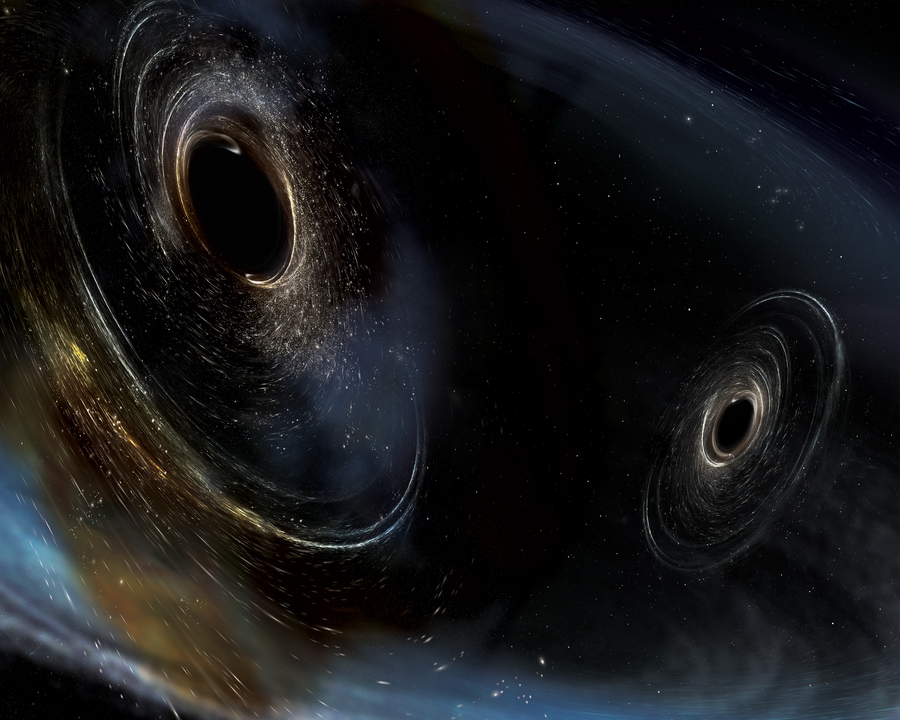
Image credit: www.ligo.caltech.edu
This question certainly arises when it comes to talking about the detection of gravitational waves (GW). Usually the argument is as follows: we know that there is a gravitational redshift , i.e. gravity stretches the wavelengths. It is reasonable to assume that in LIGO the light will also stretch, and the wavelengths that we use as a “ruler” to measure the distance between the mirrors will stretch to the same extent as the distance itself. So how can one use an interferometer to measure gravitational waves?
Imagine possible answers to it:
- GV do not affect the light, so the question does not make sense.
- GWs stretch the wavelength of light, but very weakly, so we do not notice.
- It does not matter, the detection principle is not sensitive to wavelength.
- Detectors do not actually work.
1. Was there a boy?
To begin with, the detectors still work.

Cemetery of stars: masses of neutron stars and black holes known to us, including LIGO observations. Image credit: www.ligo.caltech.edu
At the moment, we have seen more than a dozen events with GB. The most convincing one is the joint detection of GW and flashes of light from the fusion of neutron stars. In LIGO, they saw the GW, triangulated the area in the sky, where they come from, and said to the telescopes: “Look there!” They looked, and saw the outbreak of the kilon exactly where indicated from LIGO. So there is little doubt that it works. Let's see how exactly.
2. What is LIGO in general?

The Virgo detector is a European detector, one of three detectors that have seen gravitational waves. Image credit: www.ligo.caltech.edu
A gravitational wave, arising from the merging of massive objects (for example, two black holes), propagates in space-time as a small perturbation of its curvature. This leads to the fact that the distances between objects slightly change when the wave passes through them (more precisely, the very definition of distance changes). In LIGO, the two arms of a 4 km Michelson interferometer change by ~ 10 -18 m, and the detector is able to detect this change. An important point: if the waveguide stretches one arm of the interferometer, the second arm will be compressed proportionally (ideally, this follows from the quadrupole nature of the waveguide and the presence of two polarizations).
There is already a good article on Habré about the LIGO device , so let's move on to the answer to the question posed at the beginning of the article.
3. Measurement concept
Animation that demonstrates the detector’s principle of operation
To begin with, consider an example that will help to understand the basic principle of the detector’s operation.
This detector works with continuous light - the laser constantly pumps the resonators in LIGO with light, and photodiodes constantly detect the presence / absence of a signal. But for example, let's simplify the scheme: suppose we have a photon source that simultaneously sends photons in two directions, there they are reflected from the mirrors and returned to the photon detector (in our case, the beam splitter), as shown in the illustration below.
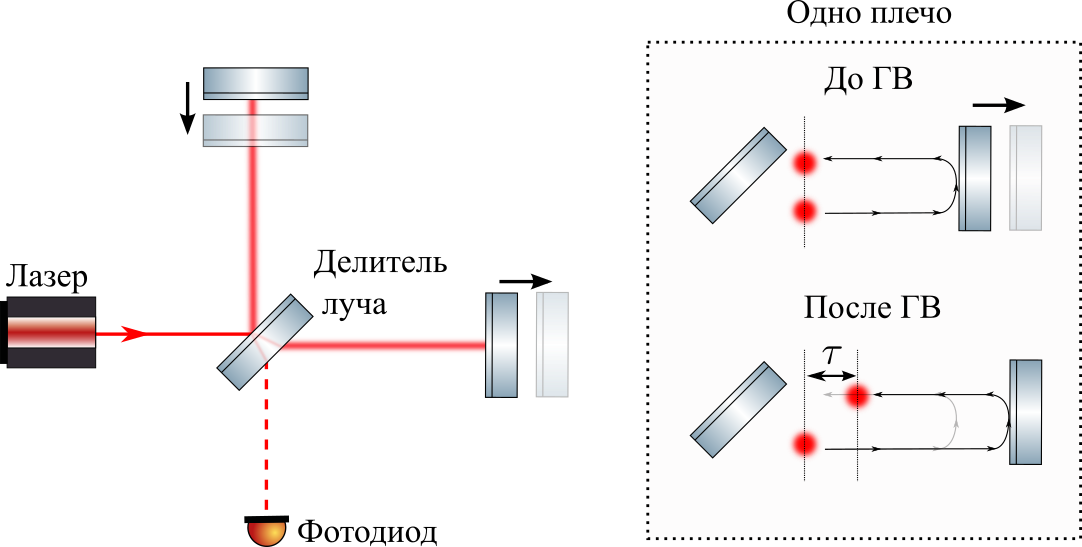
If two mirrors are at an equal distance from the photon source, two photons will return to the detector at the same time (as in the figure above). If GW stretches one shoulder on
The detector is not a ruler, but a clock
4. Detailed explanation
Let us now consider the Michelson interferometer, into which they shine with a continuous laser, the beam is divided evenly by the beam splitter, reflected from the final mirrors and, returning back to the beam splitter, interferes.
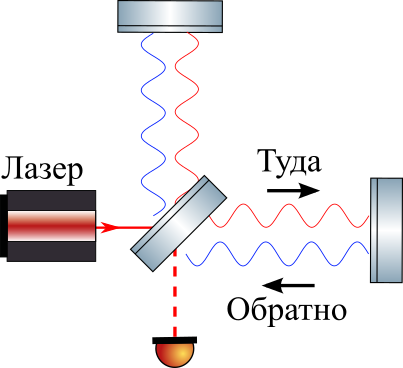
For simplicity, we assume that the GW is a "step" - it instantly changes the metric by a small amount
Note: it is important that the representation of the GW as a “step” is only useful for consideration on the fingers, in reality it is necessary to consider the GW as a wave with a certain length.
Consider what happens to light at this moment.

At the time of the arrival of the GW, the wavelength of light is stretched relative to the original wavelength (translucent curves). NB: the wavelength shown is comparable to the shoulder length for clarity, in fact, the laser wavelength is about 1 micron, and the shoulder length is 4 km.
If the mirror had a knot of a standing wave before stretching, it will remain there after stretching, as shown in the picture above. Why? This is required by the theory of relativity: since there is no separate independent rest system, the node has nothing to do but stay where it was relative to the surface of the mirror. That is, the wavelength increases in
So it turns out that all the same the light was stretched along with the detector, and we can not register the signal?
And yet we can!
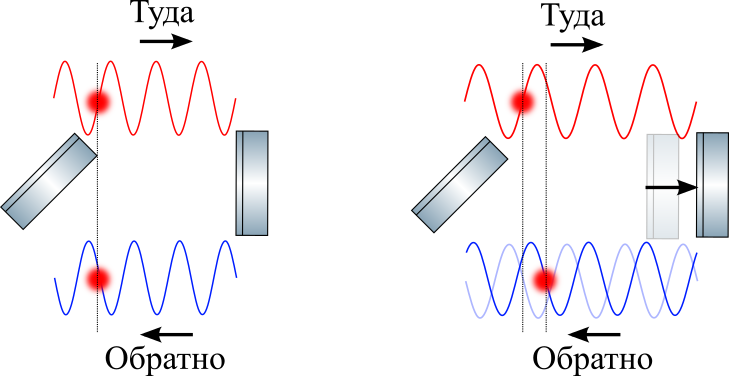
We will show this in the picture above: we will trace the path of a particular node in a stretched wave on the way there and back, marking it with a circle. Despite the stretching, light still propagates at the speed of light. This means that for the part of the wave that has just entered the shoulder, it will take more time to overcome the round trip (recall here paragraph 3 from the article). That is, its phase upon arrival will change (as can be seen in the picture).
Moreover, light continues to pump light with an unstretched wavelength.
The phase accumulated by the light on the way from the divider to the mirror and vice versa depends on the natural frequency of light
It can be shown (for example, here or here ) that if the wavelength of the HW is much greater than the length of the arm of the interferometer, the natural frequency practically does not change. And the delay time will depend on the distance between the mirrors:
Accordingly, upon arrival of the beam divider, the phase of light will have a delay, depending on the size of the metric
From this equation, by the way, it is obvious why the detector has such a long arm - the longer the length L compared to the wavelength, the more sensitive the detector. Next-generation detectors, such as the Einstein Telescope or Cosmic Explorer , will be even longer - from 10 to 40 km.
I note that in reality the GW is not a “step”, it is a wave with a wavelength much longer than the shoulder length, so that, while one “node” of the light wave passes back and forth, its stretching can be neglected. Therefore, the first moment of "stretching" of light from the consideration "on the fingers" is actually virtually absent.
So, the conclusion. The correct answer to the question is at the beginning of the article: both 2 and 3 - gravitational waves act on light a little differently than on the distance between the mirrors, but this does not matter, since in any case we measure not the wavelength, but the phase delay. In other words,
The gravitational wave detector works like a clock, not like a ruler.
5. Conclusion
It is important to emphasize that the gravitational wave affects the wavelength of light differently than the distance between the mirrors. This is due primarily to the fact that the period of the GW is much longer than the time it takes for light to go back and forth. The arm of the interferometer continues to stretch over time, following the period of the GW, and the light is constantly coming "new" from the laser.
In addition, the real detector has additional mirrors that create several resonators, which effectively increase the length of the shoulder. However, this does not affect the main idea.
So we can really observe gravitational waves, and no conspiracy theories!
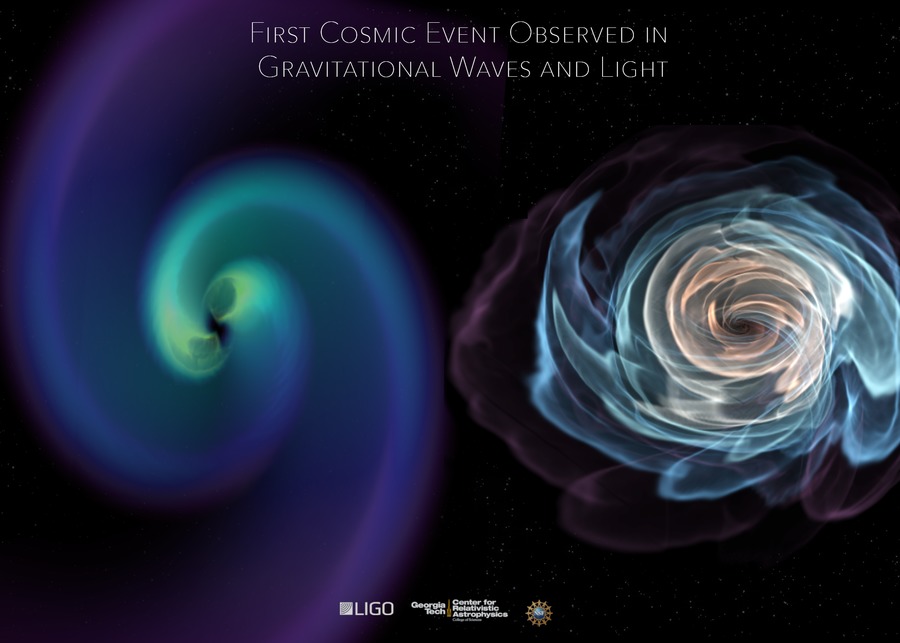
Image credit: www.ligo.caltech.edu
6. LIGO News
As a postscript, a little about what is happening in LIGO now. The second cycle of O2 observations brought not only the observation of the fusion of neutron stars and the first joint observation of GW by three detectors , including Virgo, but also many other events. In the very near future, the results of data analysis will be published, and the data itself will be open and available for analysis.
LIGO is now completing numerous updates, including the installation of compressed light and a more powerful laser, which will increase the sensitivity of the detector by several times and allow you to observe much more events (in a good scenario - by event per week).
At the beginning of next year, a new O3 observation cycle will begin.
Literature
[1] P. Saulson "If light waves are stretched by gravitational waves, how can we use light as a ruler to detect gravitational waves?" .
[2] V. Faraoni, A common misconception about LIGO detectors of gravitational waves , Gen. Relativ. Gravit 39, 677 (2007).
[3] LS Finn, Response of interferometric gravitational wave detectors , Phys. Rev. D 79, 022002 (2009).
[4] SA Hughes, Gravitational Waves from Merging Compact Binaries , Annu. Rev. Astron Astrophys. 47, 107 (2009).
[2] V. Faraoni, A common misconception about LIGO detectors of gravitational waves , Gen. Relativ. Gravit 39, 677 (2007).
[3] LS Finn, Response of interferometric gravitational wave detectors , Phys. Rev. D 79, 022002 (2009).
[4] SA Hughes, Gravitational Waves from Merging Compact Binaries , Annu. Rev. Astron Astrophys. 47, 107 (2009).
Only registered users can participate in the survey. Please come in.
What else to write about?
- 54.4% How will the new Einstein Telescope 158 Detector be arranged
- 47.9% How quantum noise limits detector sensitivity and what to do 139
- 51.3% Quantum optomechanics: how light interacts with massive objects 149
- 46.5% Laboratory of quantum optics: personal experience and many photos 135
- 8.6% Other about LIGO (option in the comments) 25
